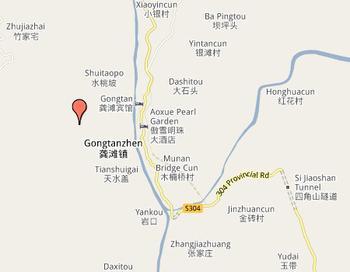Gongtan Guide: Scenic Spots
Xiqin Guild Hall: The grandest construction in the town, it is completed in the local architectural style. The exterior wall is painted red and the floor is paved with stone slabs. Facing west to the street, the construction includes a main hall, a side hall, a penthouse, and a theater. As the hall resembles a place of worship, locals usually refer to it as the “Red Temple.”
The Yard of the Ran: The Rans are a notable Gongtan family. The yard is said to have a history of over 300 years. Its style is similar to Huizhou residential dwellings, but differs in that one side is open, the corridor connecting different buildings extends to the street, and the main and side halls feature a column and tie construction style. All these are typical Gongtan architectural features. The yard thus integrates the Huizhou style and local characteristics.
The Yard of the Xia: There is an old local saying: “The most beautiful maidens come from the Yard of the Xia.” Having managed the salt trade for generations, the Xia family grew very rich, and their women were renowned for their fine clothes and exquisite jewelry. A board hanging on the main gate is inscribed “Cixiao,” meaning parents love their children and children honor their parents. “Cixiao” is one of the principal tenets of Confucianism.
The Ancestral Hall of the Dong: The hall was built with donations from the wealthy Dong family. Walking up the several stone stairs and over the high stone threshold, visitors see an ancient wooden main hall with a square patio. Dishonored members of the Dong clan would receive punishment there, and important clan matters would be discussed by elders. Memorial tablets recognizing the heads of the clan are also enshrined in the hall.
Transportation

Geographic isolation and inconvenient transportation meant Gongtan’s economy suffered in the 20th century. Today it is prospering thanks to tourism generated by its growing reputation as one of the region’s best-preserved “ancient” towns.
Trains run from Chongqing, Changsha and Huaihua to Youyang. From Chongqing the journey takes four to five hours.
From 9 am to 6:30 pm regular buses run from Chaotianmen Bus Stop in Chongqing to Youyang. The trip takes roughly four and a half hours.
From Youyang, a minibus to Gongtan Town takes approximately two hours.
Souvenirs and Delicacies
Xilan Kapu means “flowery sheets” in the Tujia language. The cloth is said to be filled with the wisdom of the Tujia and is known as the “flower of the Tujia.” Each family’s piece is a cherished possession. Every Tujia girl must be able to weave a piece of Xilan Kapu before getting married.
Gongtan stuffed tofu is one of the town’s traditional delicacies. It is traditionally served at weddings of the Tujia ethnic group, served to guests at birthday parties and presented when new houses are finished or when babies are born.
Gongtan mung bean powder is a favorite native dish. It is on sale throughout the town and makes for a tasty souvenir.
Gongtan Shaobai, made of sliced pork belly, is a special dish popular in Sichuan and Chongqing. Though its fat content is fairly high, it is not greasy after being steamed with various seasonings.
Yiju tea is a special product of the namesake town perched at an altitude of over 800 meters and shrouded in mist all year long. As early as 800 years ago, the tea produced here was presented to the head of the province as tribute. Yiju tea leaves are rich in vitamins, especially in amino acids. Yiju is also known as the “Town of Tea.”
Kuqiao Wine is Tujia’s alcoholic staple. Kuqiao, or tartary buckwheat, is grown in the area, usually without chemical fertilizer or pesticides. It is an ingredient in popular local dishes, and is also used in Chinese medicine.
Gongtan fungi are a rare class of wild fungi that resist artificial culture. It has many medical functions
Source:China Today
Editor:Jinxin
